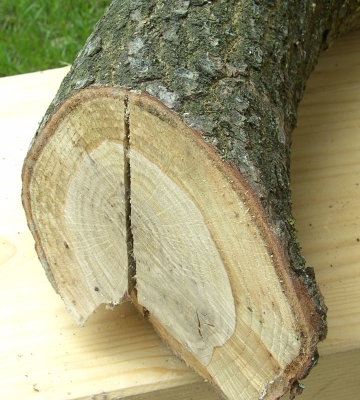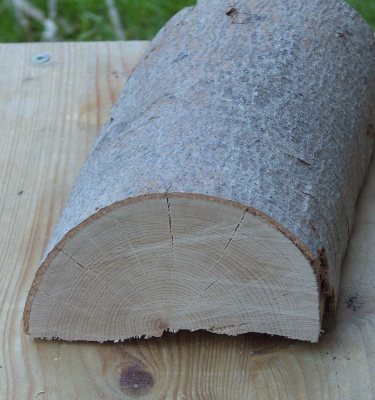Wood species
On the following pages I try to give a - really short - overview of the woods I use.
Usually all woods used come "from the neighbour's garden" and are stored and dried by me until I can use and carve them. Sometimes there are special rarities, about which I have found only insufficient information, if at all. For example rhododendron or rose root tuber.
The only wood I buy is linden, as I have not found a source in my area yet.
For some of my works I even use glued wood - I will not describe it here. It is a very interesting material. It is a very soft, long fibered wood with a beautiful grain. But see for yourself in the "My works" section.
If we talk about oak we usually talking about ethe English oak (Quercus robur) and the sessile oak (Quercus petraea). The properties of the two timbers are nearly identical, so we generally only speaks of oak.
The difference between heartwood and sapwood is clear. The sapwood appears off-white od and the heartwood is yellow-brown to medium brown. The wood will darken considerably. The heartwood contains a lot of tannic acid.
The wood is medium to high and harmonized and has excellent strength and elasticity properties and high wear resistance. It is densely fibred and moderately tight. It is easy to divide and easy to work well, but it tends a little to the formation of cracks.
The wood should be dried slowly, otherwise it tends to crack and discards. It shrinks moderately and often it gets a darker color on drying.

When oiling it must be noted that the sapwood is to osak well and the heartwood is very difficult. Heartwood is submerged almost indefinitely. Sapwood, however, is more susceptible to weathering.
Die Douglasie(Pseudotsuga menziesii) wurde etwa 1828 von Amerika nach Europa eingeführt und kann seit ca. 1880 als heimisch angesehen werden.
Sapwood and heartwood are clearly different from the Douglas fir: The sapwood is yellowish to reddish-white, fresh heartwood yellowish brown to reddish yellow, which darkens to a reddish-brown to dark quickly. Especially with dark coloring, there is a certain resemblance to the wood of the larch. The trees grow in the first 50-60 years very quickly, resulting in forming the heartwood initially broader (5-10mm), later thinner growth rings. Depending on location and growing conditions the grain of the wood and its properties change dramatically. Fine growth rings, a few branches and low resin content are generally signs of good qualities. The wood of Douglas fir is moderate and - relative to other conifers - comparatively hard. It shrinks not very much and is distinguished by good dimensional stability. The Douglas fir has good strength and elasticity properties. The wood is exposed to a good resistance to fungi and insects, and even the weather, it is a good natural durability. Due to the possible resin outlet, one has to take care when choosing the wood. Wood with fine rings is soft and can be worked generally better than the one with bigger rings.
The beech (Fagus sylvatica) is one of the most important native hardwoods and is used in many ways, especially in furniture and interior design.
 Beech wood is heavy, hard, very tough and very stable.
Beech wood is heavy, hard, very tough and very stable.
It has different colors. It is well recognized by the many small mirrors on the wood surface.
Beech "works" more than other woods and it shrinks pretty strong.
Beeches belong to the heart wood trees. Sapwood and heartwood is reddish brown equally pale yellowish to reddish-white steamed. The wood is fine-pored and has a uniform structure, it is usually not recognizable grain.
O ld trees have under certain circumstances a reddish brown color, which is called "red heart".
The surface can be worked easily edited and polish.
The wood of the birch (betula) is mainly sapwood, the heartwood is more dark, not very often violet. The wood is hard, heavy and elastic.
 Overall, it is a brightly colored, rather simple wood. The annual rings are separated by narrow strips of latewood. Depending on the fiber orientation very beautiful patterns could emerge.
Overall, it is a brightly colored, rather simple wood. The annual rings are separated by narrow strips of latewood. Depending on the fiber orientation very beautiful patterns could emerge.
The wood is easy to carve and to work well. It can also be polished very well and is also very popular with woodturners.

The wood of the birch (betula) is mainly sapwood, the heartwood is more dark, not very often violet. The wood is hard, heavy and elastic.
 Overall, it is a brightly colored, rather simple wood. The annual rings are separated by narrow strips of latewood. Depending on the fiber orientation very beautiful patterns could emerge.
Overall, it is a brightly colored, rather simple wood. The annual rings are separated by narrow strips of latewood. Depending on the fiber orientation very beautiful patterns could emerge.
The wood is easy to carve and to work well. It can also be polished very well and is also very popular with woodturners.

Page 5 of 6



